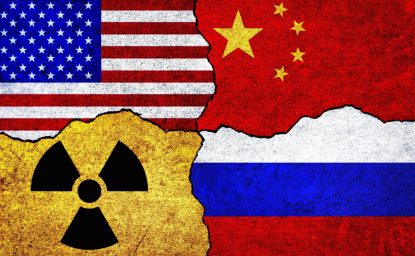The latest step in the reshaping of the Middle East political order took place last week with the visit of Turkish President Recep Tayyip Erdogan to Saudi Arabia after years of extremely strained relations between the two countries. It demonstrates dramatically how realpolitik is taking over the fractious region as old enemies and rivals seek to deal with changing international circumstances and find ways to accommodate rather than confront each other.
In February, Erdogan went to Abu Dhabi to make peace with the rulers of the United Arab Emirates and then in March welcomed Israeli President Isaac Herzog, the first such visit in 14 years.
The result has been a slightly surreal spring of détente across the Middle East. Iran and Saudi Arabia, bitter foes for primacy across the Arab world, just completed a fifth meeting of their senior security officials, and one between foreign ministers may be in the offing. In March, Israel hosted the first meeting ever of foreign ministers from four Arab states on its soil. In February, Erdogan went to Abu Dhabi to make peace with the rulers of the United Arab Emirates and then in March welcomed Israeli President Isaac Herzog, the first such visit in 14 years.
A rare alignment
The four emerging regional powers—Saudi Arabia, Turkey, Iran, and Israel—are all in search of new allies for their respective causes, even as they try to figure how they will deal with each other in a less confrontational manner. The background to this rethink in approaches is the perceived US pivot away from the Middle East to focus on challenges from Russia and China. Russia, until recently has been rising in the region but may now have to execute its own “pivot” away from the Middle East to deal with its war in Ukraine and confrontation with NATO. (The Financial Times reported last week that Russia pulled over 1,000 Russian and Syrian mercenaries out of Libya and sent them to Ukraine.)
Another element in the new Middle East landscape is that the three traditional power centers —Baghdad, Cairo, and Damascus—are currently preoccupied with their internal economic and political problems and have been reduced to only minor players in the reshaping of the Middle East order. Most striking is that Egypt, once the central powerhouse in the region, has faded from any leadership role and become beholden to the Arab monarchies of the Gulf for tens of billions of dollars in financial and economic aid to ensure its stability.
The meeting between Crown Prince Mohammed bin Salman (MBS) and President Erdogan in Jeddah on April 28 stands out as the most extraordinary example so far of the “new era” being declared among former Middle East foes. Erdogan and MBS had been at swords’ points ever since 2018. The Turkish leader promised to move “heaven and earth” to bring to justice those responsible for the brutal murder of Saudi journalist Jamal Khashoggi inside the Saudi consulate in Istanbul that October. Turkish security leaked to the media conversations they had secretly recorded among the Saudi assassins from inside the consulate, linking the operation to MBS’ closest aides. Erdogan ordered a trial in absentia for 26 implicated Saudi agents, but then closed it down April 7 to make possible his reconciliation with MBS.
Another was the end to a bitter feud between Saudi Arabia and Qatar in which Erdogan had sided with the latter. Saudi Arabia had led three Gulf Arab monarchies and Egypt in a land, sea, and air blockade of the neighboring emirate starting in 2017 to force it into complying with their foreign policies. Erdogan even sent Turkish troops to guard the Qatari border against possible Saudi attacks. The blockade failed, and thanks to pressure from former President Trump it was lifted just before he left office in January 2021.
The Turkish leaders sided with the Muslim Brotherhood as it gained power after the 2011 Arab uprisings toppled four authoritarian Arab leaders and challenged the legitimacy of the Gulf monarchies. Ankara and Istanbul came to serve as centers for its opposition in exile, though Erdogan has recently curbed its activities there.
Will the “new era” last?
Where this spring of diplomatic bonhomie and talk of “new eras” among former foes is leading is far from clear. The struggle between Iran and Saudi Arabia for regional primacy is still very much alive and well, with its epicenter for the past seven years in the civil war in Yemen between Iranian- and Saudi-backed factions. Turkey is a bigger military power than either of these two, and until recently Erdogan had espoused dreams of establishing a reiteration of the old Ottoman Empire that had once included much of the Arab Middle East. It still has its military finger in parts of Syria, Iraq, and Libya.
Each of these four regional powers has different expectations and goals in mind. Erdogan seeks to tap into the plentiful coffers of Saudi Arabia to obtain billions in financial aid and investments for his seriously ailing economy. Israel wants its Arab partners to help it deal with the military threat from Iran in the region and Hezbollah in Lebanon and neutralize pressure for a Palestinian state. MBS wants Erdogan to drop his pursuit of the Khashoggi murder case and join Saudi Arabia in an alliance of Sunni Arab nations to act as a counterweight to Shiite Iran. The crown prince has achieved his first objective, but Turkey is unlikely to join in such an alliance against Iran as it doesn’t experience the same threat.
A breakthrough in the Saudi-Iranian talks toward accommodation rather than continued confrontation is one essential prerequisite.
How long will this “new era” of détente last? Is a new security architecture shared by these four regional powers really possible? Whether Iran can be integrated into such an arrangement may well hold the key. A breakthrough in the Saudi-Iranian talks toward accommodation rather than continued confrontation is one essential prerequisite.
The successful outcome on talks between Washington and Tehran in Vienna on the fate of the near-defunct 2015 Iran nuclear deal is another. This will likely determine the fate of the fledgling Middle East détente among these four regional powers. If there is a US-Iranian agreement to return to these accords, then Washington is indeed likely to disengage from the Middle East to focus more singularly on Russia and China. This would serve to encourage these four to continue their quest for a peaceful modus vivendi.
However, if there is no agreement and Iran proceeds toward building a nuclear bomb, then today’s budding détente will probably be the first victim. The rivalry between Iran and Saudi Arabia could well turn into a nuclear arms race—in fact, MBS has promised just that. Chances of military action by Israel or the United States, or both together, against Iran’s nuclear facilities will also increase enormously. The only “red line” President Biden has publicly drawn in his muddled Middle East policy is never a nuclear Iranian bomb.
The Vienna talks have been stalled for over a month, and prospects for their success continue to dim. Thus, it is difficult to be optimistic about a lasting détente in the Middle East.
The views expressed in these articles are those of the author and do not reflect an official position of the Wilson Center.
Author

Former Washington Post Middle East Correspondent

Middle East Program
The Wilson Center’s Middle East Program serves as a crucial resource for the policymaking community and beyond, providing analyses and research that helps inform US foreign policymaking, stimulates public debate, and expands knowledge about issues in the wider Middle East and North Africa (MENA) region. Read more

Explore More
Browse Insights & Analysis
US Inaction Is Ceding the Global Nuclear Market to China and Russia

Promoting Convergence in US-Brazil Relations




